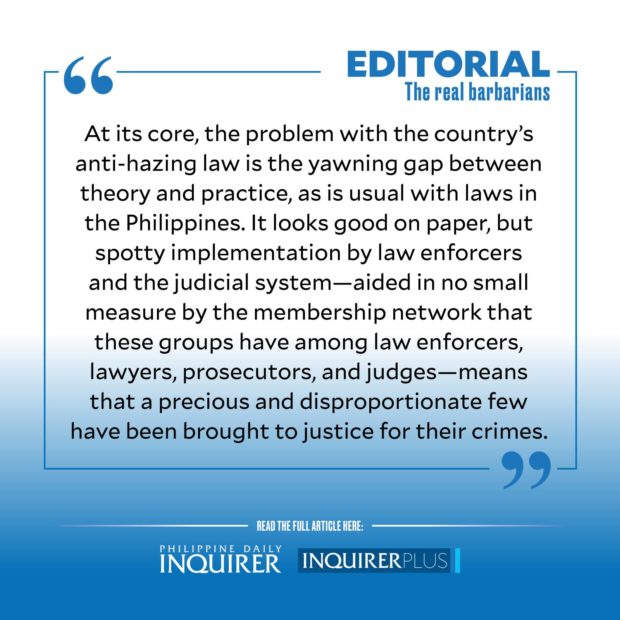The real barbarians
 In the language of fraternities, they are called “barbarians.”
In the language of fraternities, they are called “barbarians.”
This derisive term is used to describe people who are not members of tightly-knit “brotherhoods” that charge as an admission fee the steep price of being beaten on the posterior of the applicant’s thighs, or sometimes buttocks, with a wooden paddle.
The result is always, at least, heavy bruising and hematoma. Sometimes, the heavy beatings result in fractures. And every now and then, the price an initiate tragically pays for the dubious honor of being called a “brother” is the ultimate one: his life.
And in the case of the Tau Gamma Phi, the price that initiates have paid has been one life too many—at least 15 lives over the last two decades, in fact, giving it the dubious honor of having the highest number of fatalities among all the fraternities in its over five decades of existence.
This is a higher number of lives sacrificed at the altar of a purported brotherhood than even older fraternities like the 73-year-old Alpha Phi Omega (at least six deaths recorded) and more than double the number of hazing deaths at the Philippine Military Academy (at least six) since the public started tracking the issue in the 1950s.
All told, almost 60 young men have perished at the hands of their would-be brothers for the right to be accepted into an exclusive group and not be called barbarians. The real number is almost certainly higher, given the secrecy that many members of these groups are sworn to.
Yet, a cursory look at the country’s legal and enforcement landscape would tell any observer that all these senseless deaths are preventable.
After the 1991 death of Ateneo law student Leonardo “Lenny” Villa at the hands of the Aquila Legis fraternity, a tough and comprehensive law—the Anti-Hazing Act of 1995—was put in place in the wake of the public outrage that followed.
Entitled “An Act Regulating Hazing and Other Forms of Initiation Rites in Fraternities, Sororities, and Other Organizations and Providing Penalties Therefor,” Republic Act No. 8049 mandated that the death or physical injury suffered by any person during these activities would be punishable by jail time of anywhere between four years to life imprisonment.
Yet, after a brief lull, the deaths resumed, with the 2000s and the 2010s particularly bloody and brutal for college and university students, aspiring lawyers, and military and police cadets whose only shortcoming was wanting the acceptance, camaraderie, and academic and career support that these fraternities promised.
Following this surge, the law was amended, resulting in the enactment of the improved and enhanced Anti-Hazing Act of 2018 where hazing was no longer just “regulated” as the law’s previous incarnation tried to do, but was banned outright in all its forms.
At least seven more young lives, but almost certainly more, have been snuffed out in these barbaric rites meant to welcome young men into the nonbarbaric world since then.
At its core, the problem with the country’s anti-hazing law is the yawning gap between theory and practice, as is usual with laws in the Philippines. It looks good on paper, but spotty implementation by law enforcers and the judicial system—aided in no small measure by the membership network that these groups have among law enforcers, lawyers, prosecutors, and judges—means that a precious and disproportionate few have been brought to justice for their crimes.
There is no easy solution to this conundrum, since the fraternities are so deeply embedded in local society. But certainly, better enforcement of the law is a key element. President Marcos Jr.’s vow to bring to justice the killers of another young man and his dreams is an important first step. Then there is the prosecution, with the wheels of justice turning ever so slow in these hazing deaths, as they do in practically most other cases in the country.
Going forward, educational institutions must take a more proactive stance against fraternities, the way they did in the wake of Lenny Villa’s death in the 1990s before the notorious “ningas cogon” attitude squandered the gains from that supreme sacrifice and led to the return of fraternities and hazing with a vengeance.
Less than three weeks ago, 24-year-old John Matthew Salilig, a chemical engineering junior at the Adamson University, attended initiation rites by the Tau Gamma Phi fraternity. During a two-hour period, his would-be brothers delivered 70 paddle blows to his lower extremities, causing him to vomit, defecate, and lose consciousness. Instead of taking him to a hospital, his would-be brothers buried him in a shallow grave, where his decomposing body was found almost two weeks later.
Yes, the world is divided into brothers and barbarians.
But the real barbarians are not the uninitiated but the very members of these fraternities themselves.




















